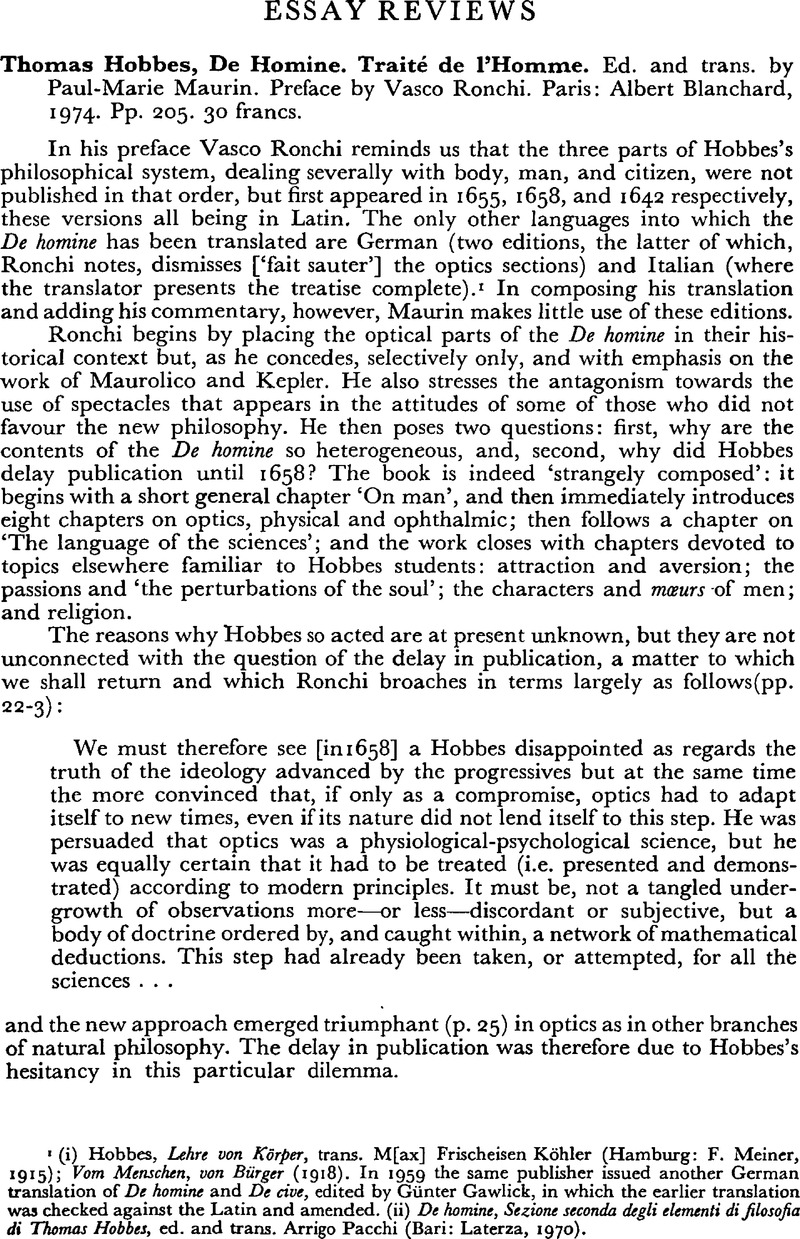No CrossRef data available.
Published online by Cambridge University Press: 05 January 2009

1 (i) Hobbes, , Lehre von Körper, trans. Köhler, M[ax] Frischeisen (Hamburg: F. Meiner, 1915)Google Scholar; Vom Menschen, von Bürger (1918)Google Scholar. In 1959 the same publisher issued another German translation of De homine and De cive, edited by Günter Gawlick, in which the earlier translation was checked against the Latin and amended, (ii) De homine, Sezione seconda degli elementi di filosofia di Thomas Hobbes, ed. and trans. Pacchi, Arrigo (Bari: Laterza, 1970).Google Scholar
2 Gassendi, , … Operum tomua secundas, quo continentur Syntagmatis Philosophici…membra duo … (Lyons, 1658; facsimile, Stuttgart, 1964), p. 305.Google Scholar
3 Critique du ‘De mundo’ (see note 5), pp. 147, 177, 391.Google Scholar
4 Ibid., pp. 116, 163–4.
5 (i) Tractatus opticus, item 22 of British Museum Harleian MS. 6796, leaves 193–266, printed in its entirety by Alessio, Franco in Rivista critica di storia della filosofia, xviii, fase. II (1963), pp. 147–228Google Scholar, and, in part, by F. Tönnies in Appendix B to his edition (1889; reprinted 1928, 1969) of Hobbes's Elements of law.
(ii) The comment of Descartes, to Mersenne, of 18 02 1641/1642Google Scholar in a letter editorially endorsed ‘pour Hobbes’ (Descartes, , OeuvresGoogle Scholar, ed. Adam, et Tannery, , Correspondence, iii [1899], 315–18.Google Scholar
(iii) The optical sections of Hobbes's Critique du ‘De mundo’ de Thomas White (i.e. the untitled MS. fonds latin 6566A in the Bibliothèque Nationale, Paris; ed. Jacquot, J. and Jones, H. W.. [Paris: Vrin, 1973]):Google Scholar
(iv) Tractatus opticus (not the same work as [i] above), forming Book VII of the optics section in Mersenne's Cogitata physico-mathematica (1644; see also the section ‘Ballistica‘, pp. 75–82Google Scholar) and included in Molesworth's edition of Hobbes, 's Opera latina, v (1845), 215–48:Google Scholar
(v) The still unpublished Harleian MS. 3360, leaves 1–193, of which alone leaves 2–4 and 192–193 were issued by Molesworth in Hobbes, 's English works, vii (1845), 467–71Google Scholar. On this last manuscript, which Ronchi dates 1646. see Alessio, 's paper, ‘De homine e A minute or first draught [the MS. has draugt] of the optiques di Thomas Hobbes’, Rivista critica, xvii, fase. IV (1962), 393–410Google Scholar. This is not the sole instance where different works of Hobbes are given the same title: it seems unwise to follow Rossi (details below in note 7) in abbreviating to De principiis the subtitles of MS. 5297 in the National Library of Wales (De principiis cognitionis and De principiis actionis), for confusion could occur with De principiis et ratiocinatione geometrarum (1666).Google Scholar
6 References are respectively to individual page-numbers in the edition under review (these precede the colons) and to pages of the Critique, referred to in the previous note: 48:123; 63:176; 144:126, 356; 155:360, 414; 159:415; 165:374; 166–7:359–60; 172–3:419; 174–5:360, 414–15, 424.
7 The above argument does not appear in the work of critics examining the development of Hobbes's system; their various cases will be found as follows: Brandt, F., Den mekaniske naturopfattelse hos Thomas Hobbes (Copenhagen, 1921)Google Scholar; Rossi, Mario M., Alle fonti del deismo e del materialisimo moderno (Florence, 1943), pp. 122–5, 142, 150–1, 162–3, 177, 186Google Scholar; Pacchi, Arrigo, Con venzione e ipotesi nella formazione della filosofia naturale di Thomas Hobbes (Florence, 1968), pp. 23, 39, 207ff.Google Scholar
8 OED, s.v. ‘stand with’: ‘be consistent or consonant with, agree or accord with’; Lewis, and Short, 's A Latin dictionary, s.v. stare cum, II.B.3.Google Scholar